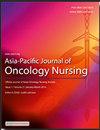探讨污名和感知社会支持在宫颈癌患者健康素养和卫生保健决策障碍之间的中介作用
IF 2.8
3区 医学
Q1 NURSING
引用次数: 0
摘要
目的探讨宫颈癌患者健康素养、病耻感和医疗决策障碍之间的关系,并确定病耻感和感知社会支持在这一关系中的中介作用。方法采用方便抽样的横断面研究方法,选取北京市三所三级医院宫颈癌住院患者322例。参与者完成了关于健康素养、耻辱、感知到的社会支持和卫生保健决策障碍的自我报告问卷。结果37.3%的宫颈癌患者出现就诊延误。发现健康素养与病耻感有显著负相关(P <;0.001)和卫生保健决策障碍(P <;0.001),与感知到的社会支持正相关(P <;0.001)。健康素养通过污名化(效应= - 0.073)、感知社会支持(效应= - 0.086)和污名化与感知社会支持的结合(效应= - 0.041)三种中介途径间接影响医疗决策障碍,分别占总效应的27.5%、32.3%和15.4%。总间接效应占总效应的75.1%。结论中国宫颈癌患者健康素养水平处于中等水平。污名化和感知到的社会支持在卫生素养与卫生保健决策障碍之间的关系中起部分中介作用。卫生保健提供者可以通过提高卫生知识素养来减少决策障碍,并通过解决耻辱和加强社会支持来间接减少决策障碍。本文章由计算机程序翻译,如有差异,请以英文原文为准。
Exploring the mediating roles of stigma and perceived social support between health literacy and health care decision-making barriers among patients with cervical cancer
Objective
This study aims to investigate the association between health literacy, stigma, and health care decision-making barriers in patients with cervical cancer and identifies the mediating roles of stigma and perceived social support in this relationship.
Methods
A cross-sectional study was conducted using convenience sampling, recruiting 322 hospitalized patients with cervical cancer from three tertiary hospitals in Beijing. The participants completed self-reported questionnaires on health literacy, stigma, perceived social support, and health care decision-making barriers. Chained mediation effects were analyzed using Amos 26.0 software.
Results
37.3% of patients with cervical cancer reported delays in seeking medical care. Health literacy was found to have significant negative associations with stigma (P < 0.001) and health care decision-making barriers (P < 0.001) and a positive correlation with perceived social support (P < 0.001). Health literacy indirectly influenced health care decision-making barriers through three mediating pathways: stigma (effect = −0.073), perceived social support (effect=−0.086), and a combination of stigma and perceived social support (effect = −0.041), collectively accounting for 27.5%, 32.3%, and 15.4% of the total effect, respectively. The total indirect effect accounted for 75.1% of the total effect.
Conclusions
The health literacy levels among patients with cervical cancer in China are moderate. Stigma and perceived social support serve as partial mediators in the relationship between health literacy and health care decision-making barriers. Health care providers can reduce decision-making barriers by improving health literacy and indirectly lessen them by addressing stigma and enhancing social support.
求助全文
通过发布文献求助,成功后即可免费获取论文全文。
去求助
来源期刊

Asia-Pacific Journal of Oncology Nursing
Multiple-
CiteScore
2.80
自引率
11.10%
发文量
136
审稿时长
31 days
 求助内容:
求助内容: 应助结果提醒方式:
应助结果提醒方式:


